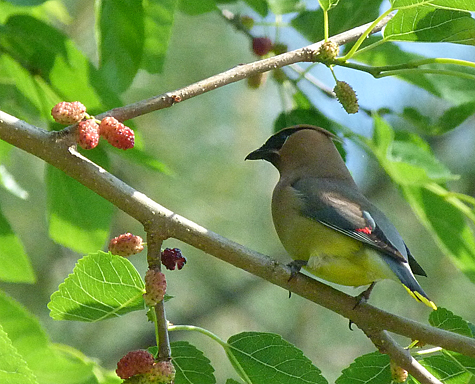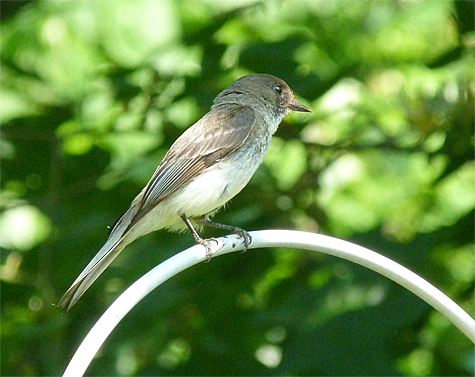I was cruising Explore the Wild and Catch the Wind for turtles that might have been looking for nest sites when I noticed that the branches of the mulberry tree that hangs over the path near the Sail Boat Pond were drooping very low. There were also many purple stains on the pavement below the branches. The mulberries were ripe. It was time to keep an eye out for berry loving birds raiding the trees in search of that oh so succulent fruit.
Just as that thought hit me, I saw one, two, then more, small groups of birds fly overhead in the direction of the mulberry tree behind the Sail Boat Pond. As I watched, the birds were flying to and from the tree. They were waxwings.

At first it was difficult to see the birds hidden among the branches as they searched for mulberries. But as more and more birds flew in to the tree, photographic opportunity presented itself to me again and again.
As I watched, the birds picked only ripe berries











During the peak of this avian assault, other birds flew in to see what all of the commotion was about.





And just as quickly as they had arrived, the birds had all disappeared.

How many scenes like this occur each day, unnoticed?
Lots of good information Greg! Thanks so much!
I thought about this blog post yesterday when I was at my local garden center looking for a Serviceberry tree and saw a new shipment of Mulberry- shrubs, I think. Wondering if I should rethink my plan. Nice shots!
The waxwings will eat the serviceberries too. However, if you have red cedar nearby you may be inviting apple-cedar rust into your yard. It, or another strain of the rust attacks serviceberry (http://www.ct.gov/caes/lib/caes/documents/publications/fact_sheets/plant_pathology_and_ecology/cedar-apple_rust_05-01-08r.pdf).
I think mulberries taste better anyway.
Good luck.
These shots are amazing!
Are Waxwings seasonal in our area? I seem to remember that they head up to Canada for the summer…
Why, thank you!
Cedar Waxwings nest in North Carolina. They are more common nesters in the mountains, less so on the coastal plain. And yes, they do nest in Canada, probably as far north as the treeline. They are definitely more common in winter throughout the state as they move around in flocks looking for ripe berries.
Amazing, as always, Greg! Do birds have a sense of taste like we do?
I’ll never forget when I saw our two bears up in a mulberry tree in their exhibit. The poor little tree was swaying back and forth under the weight of two bears swiping at each other, fighting over the fruit!
Wendy,
No, birds do not have a sense of taste like we do. Their taste buds number far fewer than ours, about 3 – 5 percent of the taste buds humans have. However, they can taste sweet, sour and bitter. I’m not sure wether or not the waxwings were enjoying the mulberries as much as they appear to have been enjoying them. Birds typically swallow small fruit whole. A hawthorne berry, crab apple, or blueberry, no matter how sweet, sour, or bitter it is can’t be tasted unless it’s bitten into. Swallowing the fruit whole doesn’t allow for tasting, the fruit is broken down in the gizzard.
Those mulberries are very soft. Just the process of picking them up can break the skin of the fruit and expose their tasty insides. So, I choose to believe that the birds were enjoying themselves while tossing back those tasty mulberries. And, although I’ve seen other birds pick mulberries that were not quiet ripe, I didn’t see any of the waxwings do so. Ripe equals sweet in mulberries.
Thanks,
good pics
Thank you, Jill.